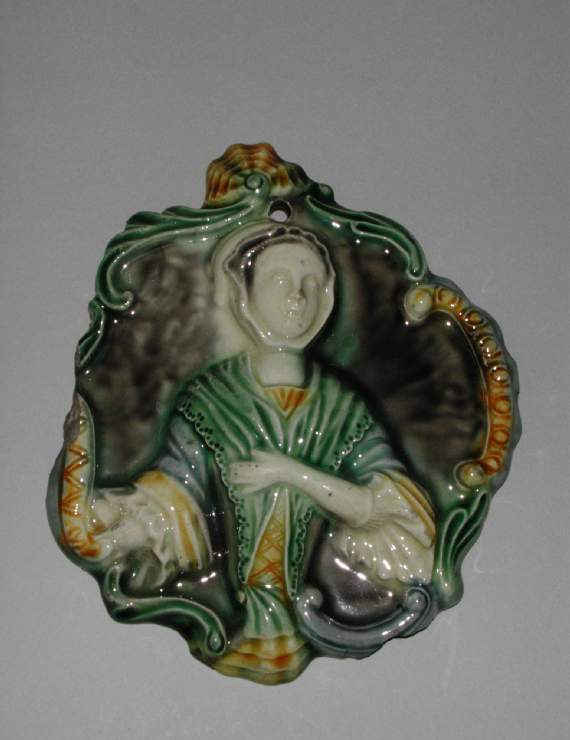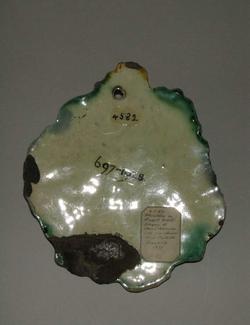Current Location: In storage
Titles
Elizabeth Canning
Maker(s)
Factory:
Unidentified Staffordshire Pottery
(Possibly)
Factory:
Indeo Pottery
(Possibly)
Entities
Categories
Description
Press-moulded lead-glazed creamware decorated with coloured glazes.
Lead-glazed creamware decorated with coloured glazes and underglaze oxides in green, yellow, slate-blue and dark grey. The press-moulded plaque bears a relief half-length portrait of Elizabeth Canning against a plain dark grey background. Canning wears a small bonnet and clutches at her shawl, which she wears over her dress. An asymmetrical frame of C-scrolls, S-scrolls, foliate patterns and, at the top, a small shell surrounds the plaque and there is a hole for hanging at the top.
Notes
History note: Provenance unidentified before sale of 29 March 1917 at Puttick and Simpson's, London, where it was Lot 106 and was bought by Mr Stoner for Dr J.W.L. Glaisher, FRS, Trinity College, Cambridge
Legal notes
Dr J. W. L. Glaisher bequest.
Measurements and weight
Height: 14.3 cm
Width: 12.4 cm
Acquisition and important dates
Method of acquisition: Bequeathed
(1928-12-07)
by
Glaisher, J. W. L., Dr
Dating
18th Century, third quarter
George III
Circa
1760
CE
-
Circa
1770
CE
Note
In his manuscript catalogue, Dr Glaisher identified the plaque’s subject as ‘Sarah Malcolm, the murderess’ after Hogarth’s portrait of the charwoman, who was executed for the murder of her mistress and two servants in 1733. However, it has since been demonstrated that the plaque in fact shows Elizabeth Canning, who was at the centre of a controversial trial that captured public imagination in the 1750s. In 1753, Mary Squires, a ‘Gypsy’, was condemned for robbing the 18 year old Canning and imprisoning her in a house of ill fame for a month. However, Canning’s testimony was called into question, leading to her conviction for perjury on 8 May 1754; she was sentenced to transportation to America. Various depictions of the case and its protagonists were printed in illustrated publications of the day, including bust-length portraits of Canning and Squires engraved by Benjamin Cole for The New Universal Magazine in 1754; Cole’s portrait of Canning was the source for this plaque. The Henry H. Weldon collection has two copies of this plaque, one of which is part of pair with another plaque derived from Cole’s portrait of Squires.
The plaque was attributed by Rackham to Staffordshire. Grigsby also attributed the similar plaques in the Weldon collection to Staffordshire. However, more recently, it has been suggested by Hillier (1996) that the plaque could have been produced at the Indeo Pottery at Bovey Tracey in Devon, c.1770. Between 1767 and 1774, Nicholas Crisp, previously involved in porcelain manufacture at Vauxhall, was working at the Indeo Works; Crisp had been prominently involved with the Canning scandal, having co-authored a pamphlet in support of Canning published in 1754.
School or Style
Rococo
People, subjects and objects depicted
Materials used in production
cream coloured
Earthenware
Lead-glaze
Coloured glazes
Underglaze colours
Techniques used in production
Press-moulding
: Press-moulded earthenware decorated with painted on coloured glazes and underglaze coloured metallic oxides; it is difficult to distinguish between colours added as powdered oxides beneath a clear lead-glaze and coloured lead-glazes
Lead-glazing
Inscription or legends present
Inscription present: stick-on octagonal white paper label with blue border
- Text: “4582. Whieldon or Ralph Wood plaque of Sarah Malcolm (the murderess). b at Puttick’s March 29 1917”
- Location: On back
- Method of creation: Handwritten in black ink
- Type: Label
References and bibliographic entries
Identification numbers
Accession number: C.697-1928
Primary reference Number: 75846
Old catalogue number: 4528
Stable URI
Audit data
Created: Saturday 6 August 2011
Updated: Tuesday 30 April 2024
Last processed: Tuesday 15 July 2025
Associated departments & institutions
Owner or interested party:
The Fitzwilliam Museum
Associated department:
Applied Arts





